This abrasive blast media guide is to help you decide what media you need for a particular job.
Brown and White Aluminum Oxide
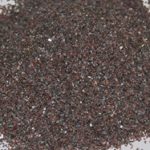
With aluminum oxide, the sifting is more precise than other blast media. You can order a specific sized grit, whereas with an abrasive media like garnet, the grit is in a range, not a specific measurement. When you need a more precise, even profile on a piece, that’s when you would use aluminum oxide.
Aluminum oxide is screened and consistent, so it gives you a more even profile. When you require an even, high-end profile, “Alox” is a good choice. Aluminum oxide is between an 8 and a 9 on the hardness scale.
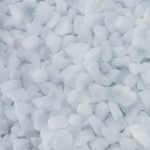
Some common industrial blasting applications for aluminum oxide are scale removal and surface preparation.
Although aluminum oxide is more expensive than other types of abrasive blast media, it can be reclaimed and re-used almost without limit. Other blast media, like crushed glass or glass beads, have an extremely short lifespan in comparison.
Garnet
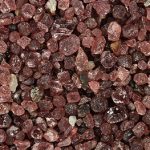
Like crushed glass, garnet creates an angular profile on the blasting surface. As an abrasive, garnet is cleans quicker and is more durable than many blasting abrasives. Many people like garnet because it produces little dust, and recycles efficiently.
The silica levels in garnet are less than 1%, so it is considered non-toxic and environment-friendly. Another advantage of garnet is it leaves very little embedded material in the blasting surface. On the hardness scale, garnet blast media will fall somewhere between a 7 and 8. (Diamond is a 10). Because garnet is a dense, hard mineral, it is extremely durable. Garnet can be used for both dry blasting and wet blasting.
Crushed Glass
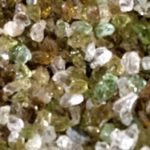
Crushed glass is mostly used as abrasive media for outdoor dry blasting. Many suppliers use recycled beer and wine bottles to create blast media. Compared to other blast media, such as aluminum oxide, crushed glass is less expensive, but has different applications. This is a blast media that is meant to be left on the ground, cleaned up, then thrown away. It is not usually recycled, like other sandblasting media might be.
Like Aluminum Oxide and garnet, crushed glass leaves an angular profile on the blasting surface. At a magnified view, you get peaks and valleys on the surface.
If you are going to repaint or powder coat a surface, an angular blast media is a good choice. This is because the powder coating sits above the profile at about 10mm, while the angular profile sits at about 3mm. This gives the powder coating or paint something to cling onto, making the surface stronger. Glass beads and crushed glass are between a 5 and 6 on the hardness scale.
Glass Bead
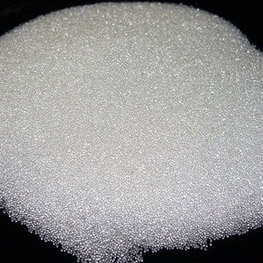
This type of blast media is a round bead, which leaves a more rounded profile after blasting. One application you might use this for would be cleaning up an engine manifold, which does not need repainting. Bead blasting is ideal when you want to clean a surface, and put it back in place.
Because of the shape of the bead, glass bead blasted surfaces are smoother than surfaces blasted with aluminum oxide, crushed glass, or garnet. Glass bead will eventually disintegrate from being blasted through the air nozzle, literally into dust.
Glass bead blasting is desirable when you do not want to leave base metals on the finished surface.
Plastic Urea
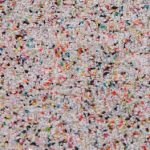
Plastic media is good for stripping paint. When you have a flat surface with paint on it, plastic urea will strip the paint and leave the surface alone.
A good use case for plastic abrasive media is when you want to remove coatings without damaging the profile surface. Plastic urea or melamine is about a 3 to 4 on the Mohs hardness scale.
Steel Shot
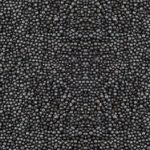
Steel Shot is round, and will have a peening effect. Similar to the effect glass bead blasting has, shot and grit leave a dimpled surface, but steel shot will last much longer than glass beads.
Because steel shot is both heavier and more durable than other blasting media, many air blast cabinets cannot handle shot blasting. For one, the siphon won’t pull steel shot unless it is very small gauge. Steel shot is usually used indoors in electric shot blasters, which use internal blast wheels and impellers to throw the shot, and gravity based reclaim systems to recycle the shot. Steel shot may also be used in blast rooms, where the shot goes through the floor and is reclaimed through a bucket and belt system.
Outdoors, shot may be used in blasting pots that will push with enough pressure to allow the use of steel shot or grit, for concrete surface preparation and other uses.
Steel Grit
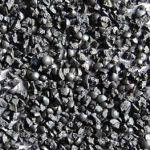
Blasting with steel grit is similar to abrasive blasting with shot, except grit will leave an angular profile, while shot leaves a dimpled profile. Steel grit can be used and recycled extensively before its lifespan is used up.
Other Blasting Media
There are many types of abrasive media used to strip and clean objects. Here are some other types of abrasive grit that are commonly used.
Silicon Carbide
One of the hardest abrasives is silicon carbide. This is a fast-stripping media with a hardness between 9 and 9.5. Silicon carbide leaves an angular profile. This abrasive can be reused several times when reclaimed.
Pumice
Made from volcanic ash, pumice is used as a mild, light-weight abrasive. This abrasive is used up rather quickly, and has a slightly angular profile. Pumice media has a hardness of about 6 to 7.
Coal Slag
This is a fast-cutting abrasive, usually used for surface preparation of uncoated metal, and sometimes concrete. Coal slag leaves an angular or cubic profile, and is about a 7 on the Mohs hardness scale.
Walnut Shells
This organic abrasive is used for stripping surfaces without leaving a ton of damage. Walnut shells leave an angular profile and have a hardness of 4½ to 5. (Note: Organic abrasives are generally cheaper to dispose of than metallic or glass abrasives).
Corn Cobs
This is another organic media, usually used for stripping wood surfaces. Corn cob abrasive has a hardness of about 4.
Peach Pits
Like walnut shell and corn cobs, peach pits are an organic abrasive that is tough, but lightweight. The organic abrasives leave little dust. Peach pits or other agricultural abrasives are generally used to strip paint from metal surfaces without damaging the substrate.
